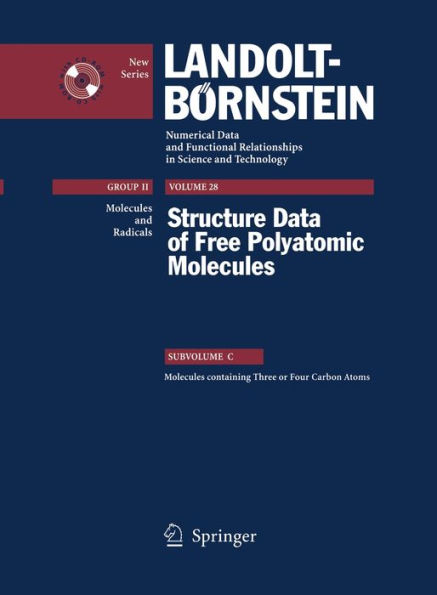Molecules containing Three or Four Carbon Atoms
Volume II/28 is a supplemented and revised edition of the preceding volumes II/7, II/15, II/21, II/23 and II/25, containing up to date information on the geometric parameters (internuclear distances, bond angles, dihedral angles of internal rotation etc.) of free inorganic and organic polyatomic molecules. All experimental methods for the determination of quantitative structural data of free molecules have been considered: microwave, infrared, Raman, electronic and photoelectron spectroscopy as well as electron diffraction. The data obtained by these methods have been critically evaluated and compiled. They are presented separately for each molecule, together with a computer-drawn schematic figure of the structure and the original literature.
1101667919
Molecules containing Three or Four Carbon Atoms
Volume II/28 is a supplemented and revised edition of the preceding volumes II/7, II/15, II/21, II/23 and II/25, containing up to date information on the geometric parameters (internuclear distances, bond angles, dihedral angles of internal rotation etc.) of free inorganic and organic polyatomic molecules. All experimental methods for the determination of quantitative structural data of free molecules have been considered: microwave, infrared, Raman, electronic and photoelectron spectroscopy as well as electron diffraction. The data obtained by these methods have been critically evaluated and compiled. They are presented separately for each molecule, together with a computer-drawn schematic figure of the structure and the original literature.
549.99
Out Of Stock
5
1

Molecules containing Three or Four Carbon Atoms
187
Molecules containing Three or Four Carbon Atoms
187
549.99
Out Of Stock

Product Details
| ISBN-13: | 9783540447399 |
|---|---|
| Publisher: | Springer Berlin Heidelberg |
| Publication date: | 02/27/2007 |
| Series: | Landolt-Börnstein: Numerical Data and Functional Relationships in Science and Technology - New Series |
| Edition description: | 2007 |
| Pages: | 187 |
| Product dimensions: | 7.99(w) x 10.87(h) x 0.04(d) |
From the B&N Reads Blog
